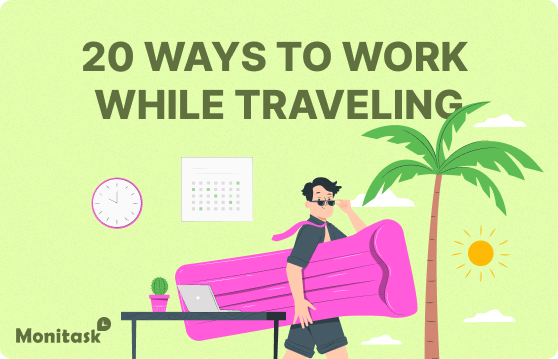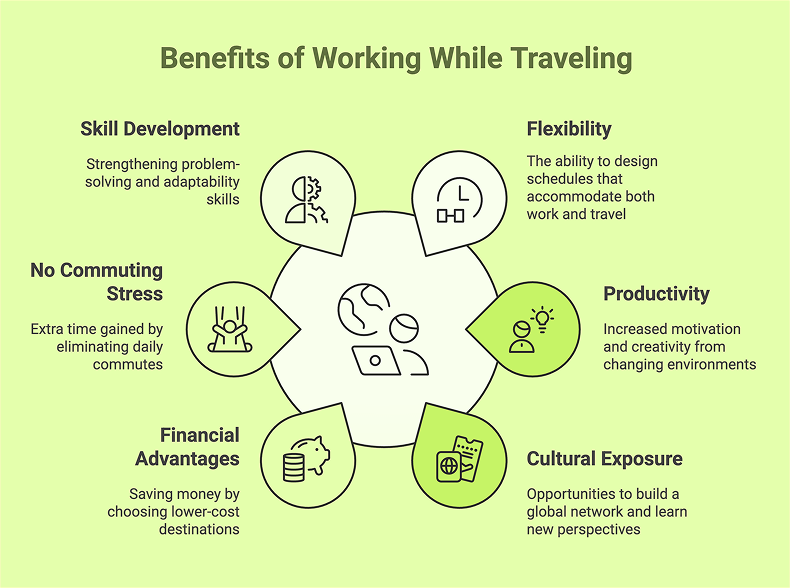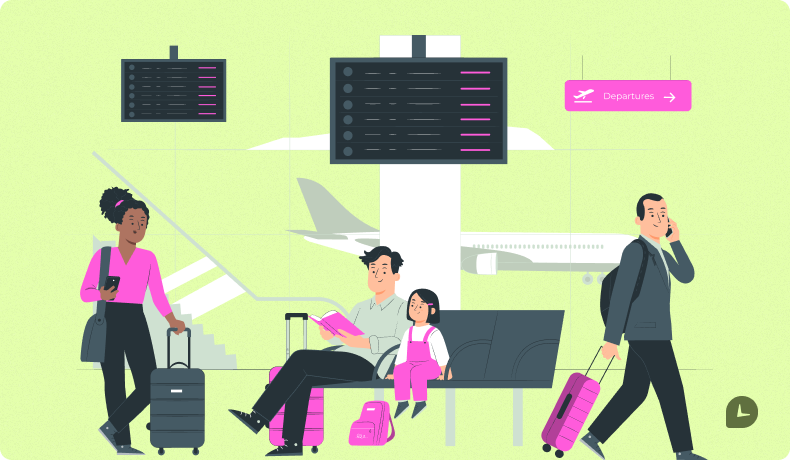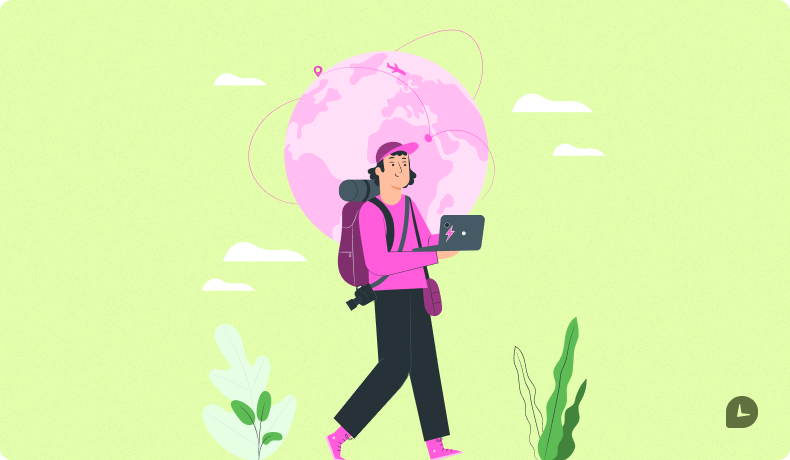
Remote work has made it possible for professionals to explore the world while staying productive.
Whether you’re a freelancer, a digital nomad, or simply taking a workation, working while traveling requires planning, discipline, and the right tools.
Here’s how you can successfully balance work and adventure.
Benefits of Working While Traveling
The rise of remote work has made it possible for professionals to blend their careers with travel, offering a lifestyle that balances productivity with adventure.
Whether you’re a freelancer, entrepreneur, or remote employee, working while traveling provides numerous advantages beyond just the freedom to explore new places. Here are some of the key benefits of working while traveling.

Balance secrets for working during travelling
1. Leverage Coworking Spaces
Coworking spaces are a great way to ensure a professional environment with reliable internet and networking opportunities. Many cities worldwide have dedicated coworking spaces that cater to digital nomads. Some popular options include WeWork, Regus, and Impact Hub, which offer flexible daily or monthly memberships. These spaces provide office-like amenities such as desks, private meeting rooms, and high-speed Wi-Fi.
2. Work from Cafés and Libraries
If you prefer a more casual setting, cafés and libraries can be excellent alternatives. Many coffee shops offer free Wi-Fi and comfortable seating, making them ideal for remote work. However, it’s important to choose locations that have a reputation for being work-friendly. Libraries, on the other hand, provide a quieter environment, ideal for deep-focus tasks.
3. Use Mobile Hotspots
Internet connectivity is crucial for remote work. A mobile hotspot or a local SIM card with a good data plan ensures you stay connected even in places with unreliable Wi-Fi. Options like Skyroam, Google Fi, or a local carrier’s SIM card can help you maintain seamless internet access while on the go.
4. Take Advantage of Airport Lounges
Long layovers or flight delays don’t have to be wasted time. Many airport lounges provide comfortable workspaces, power outlets, and fast internet. Services like Priority Pass or premium credit cards often include access to these lounges, allowing you to work in a more peaceful setting compared to crowded terminals.

5. Plan Work Hours Around Your Destination
Time zone differences can be challenging, especially if your team operates in a different region. The key to staying productive is scheduling your work hours in a way that aligns with both your employer’s expectations and your travel itinerary. If your company is based in a different time zone, early mornings or late evenings may be the best times to get work done while still leaving room for exploration.
6. Find Accommodation with Work-Friendly Spaces
When booking accommodations, prioritize places with strong Wi-Fi, comfortable workspaces, and minimal noise. Platforms like Airbnb, Selina, and Outsite cater to remote workers by offering work-friendly environments. Hotels with business centers can also be a good option for short stays.
7. Use Productivity Apps
Staying organized while traveling is easier with the right productivity tools. Apps like Trello and Asana help manage tasks, while Slack and Zoom facilitate seamless communication with your team. Time management tools like RescueTime and Clockify can help you stay on track with deadlines.
8. Automate and Delegate Tasks
Automation can reduce your workload, allowing you to focus on essential tasks. Scheduling tools like Buffer or Hootsuite can manage social media posts, while email automation tools like Mailchimp help with customer communication. If possible, delegate administrative work to a virtual assistant to free up more time for travel.
9. Travel with Noise-Canceling Headphones
Background noise in airports, cafés, or public places can be distracting. Investing in high-quality noise-canceling headphones, such as those from Bose or Sony, can improve concentration and make virtual meetings clearer.
10. Schedule Virtual Meetings Wisely
Since you may be in a different time zone than your colleagues or clients, scheduling meetings at mutually convenient times is essential. Tools like World Time Buddy can help you find overlapping work hours. If time zone differences make live meetings difficult, recording calls using Zoom or Loom allows team members to watch at their convenience.
Maximize productivity of your business
Track employee productivity and simplify work with them
11. Take Advantage of Time Differences
Time zone differences can be an advantage if managed correctly. If your employer is in a different region, you can complete your tasks before their workday even begins, making you appear extra efficient. This allows you to maximize your daytime hours for sightseeing while still staying productive.
12. Batch Your Work
To avoid constant interruptions while traveling, group similar tasks together. This method, known as batching, allows you to focus on one type of work at a time. For example, set aside a few hours solely for answering emails, then another session for deep-focus tasks like writing or coding.
13. Work on Flights and Trains
Travel time can be used productively. Many airlines and trains now offer in-flight Wi-Fi, allowing you to catch up on work. Even if Wi-Fi isn’t available, offline tasks like writing reports, editing documents, or organizing files can still be done.
14. Utilize Cloud-Based Storage
Keeping all your work files in the cloud ensures accessibility from any device. Services like Google Drive, Dropbox, and OneDrive allow you to sync documents, making it easy to work from anywhere. This also prevents data loss in case of a stolen or damaged device.
15. Have Backup Power and Storage
Carrying a power bank, extra charging cables, and an external hard drive is essential for remote workers. A dead battery or lost file can disrupt your workflow, so it’s best to have backups for both power and storage.
16. Invest in a Lightweight Laptop and Portable Accessories
Traveling with a bulky laptop can be inconvenient. Lightweight models like the MacBook Air or Dell XPS 13 are ideal for remote work. Consider a portable keyboard and a compact mouse for added comfort during long work sessions.

17. Use Offline Work Tools
Internet outages can happen, so it’s wise to have offline tools ready. Google Docs offers an offline mode, and Evernote allows you to take notes without internet access. Downloading important emails or reference materials in advance can also help in case of connectivity issues.
18. Set Boundaries Between Work and Leisure
One of the biggest challenges of working while traveling is maintaining work-life balance. Establish clear work hours and stick to them. Once your work is done, disconnect from emails and enjoy your travel experience.
19. Find Networking Events in Your Destination
Attending local business meetups and coworking space events can help expand your professional network. Websites like Meetup and LinkedIn Events list local gatherings where you can meet fellow professionals and potential clients.
20. Stay Flexible and Adapt
Travel rarely goes as planned. Unexpected delays, internet issues, or last-minute schedule changes can happen. Being flexible and adaptable ensures that you stay productive despite the challenges. Always have a backup work location in mind in case your primary spot isn’t suitable.
Conclusion
By implementing these strategies, you can maintain high productivity while traveling the world.
Whether you’re a remote employee, freelancer, or entrepreneur, these tips will help you create a perfect balance between work and adventure.
– The Monitask Team
Frequently Asked Questions
What are the best destinations for remote work?
Popular digital nomad hubs include Bali, Chiang Mai, Lisbon, Medellín, Buenos Aires and Mexico City. These places have great internet, coworking spaces, and an affordable cost of living.
How can I stay productive while constantly moving?
Plan work hours in advance, use productivity apps, and batch similar tasks together. Avoid overloading your schedule with too much travel at once.
Is it legal to work remotely while traveling abroad?
It depends on the visa and work policies of the country you are visiting. Many countries allow remote work under a tourist visa, but some require digital nomad visas or work permits.



